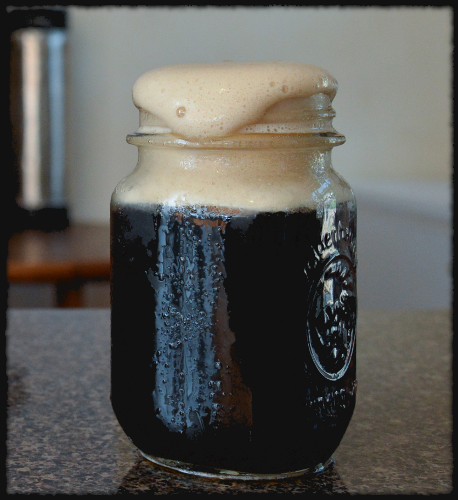
Making root beer at home is fun and surprisingly easy! You can get up and running on a small batch with very little time and money required, or you can invest some dollars and become the envy of everyone you know and start having your own wild root beer keggers!
There are 2 steps to making homemade root beer:
- Mix up the syrup
- Carbonate
Mixing up the Syrup
This step provides a lot of room for creativity because there are a broad range of flavors to choose from. You will start by heating some water to make it easier to dissolve your sweetener and other ingredients. A good place to start for your dilution ration of syrup to water is 1:4. To make the syrup this concentrated you will need heat and patience for stirring. See below for recipe. After your syrup is consistently mixed and cooled to room temperature, proceed.
Carbonating
The easiest way to carbonate your root beer syrup is by mixing in carbonated water! You can either buy the fizzy water at the store, or if you have a Sodastream or Drinkmate just use that.
A more complicated and very satisfying way to carbonate is to use a full blown keg setup so you can make the root beer yourself in bulk! For this, you will need the following:
Corney Keg
Keg Faucet
Funnel
2 gallon pot or larger
C02 tank (rent or buy)
Regulator
Gas Assembly
Kegerator (or any refrigerator big enough to hold a 5 gallon keg will do)
Pour your root beer syrup through the funnel into the keg, and fill with cool tap water leaving at least 4 inches of head space. Seal the keg with the lid, and purge the keg with carbon dioxide (CO2) to remove the outside air. Cool the entire keg to 33 degrees America. Next, hook up your CO2 to start the carbonation process. The best way to carbonate the root beer is to set your regulator to 30 PSI, purge the air out of the keg a couple times (so the air in the headspace is pure CO2), and rock the keg back and forth vigorously. You’ll be able to hear the CO2 bubbiling into the keg as it slowly carbonates. A carbonation stone can speed up this process. 10 minutes of rocking your keg on 2-3 different occasions should get you nice and carbonated. If you use the carbonation stone, gradually increase the PSI after 10 or 20 minutes by several points each time.
If your root beer is still flat, revisit your carbonation methodology. These factors will all increase the carbonation level:
- Colder temperature (as close to freezing as possible without actually freezing)
- Higher carbon dioxide (CO2) pressure in the keg. Be sure NOT to exceed 40 PSI in the corney keg unless you confirm the keg is rated higher enough to handle the pressure. Be sure to very carefully follow all the safety guidelines for your equipment.
- Agitating the liquid inside the keg by shaking it
- Additional empty head space in the keg
- Increasing the surface area of the gas touching the liquid (turning the keg on it’s side while agitating)
- Decreasing the size of the CO2 air bubbles by using a carbonation stone so they can more easily dissolve in the liquid.
Note that you’ll want to serve the root beer around 10 psi, so after shaking it, you’ll need to lower the regulator to 10 psi and let the extra pressure out. The keg will need to sit for a while and you will need to vent the excess air several times, or the root beer will be super foamy!
5 Gallon Root Beer Recipe
This is designed for a keg, but you can scale the recipe down easily if you just want to make syrup to use with carbonated water. To scale a recipe down for syrup, you generally want to make approximately 1 gallon of syrup in a pot to then mix with 4 gallons of water. You don’t have to measure the water if you use a keg, because you will just fill it within a few inches of the top.
Heat up 1 gallon of water. Exact temperature doesn’t matter, but the hotter it is, the faster the sugar will dissolve. Stoves, microwaves, and electric kettles are all great. After the hot water is in your stock pot, stir in:
8-9 cups of sugar. Honey can also be substituted for some of the sugar, but keep in mind that 1 cup of honey tastes sweeter than 1 cup of sugar. Feel free to experiment to taste, since some people like sweeter soda than others. Make sure you stir the sweetener or it may burn if your stove is on high.
4 oz Root Beer Extract. Many different varieties exist. This is one of our favorite: Zatarain’s
Next, add your signature taste. This is the fun part. Feel free to go crazy! Recommend starting with 2-3 tsp if it’s a liquid extract. Vanilla isn’t as strong as some liquid extracts, so more vanilla is fine. Powder spices vary in potency. Recommend starting with 1 tsp and adding more to taste. If you’re using an essential oil (food grade), be very careful! 10 DROPS of wintergreen is a good starting point. Some essential oils are so strong 1 drop can be overpowering! A good list of options for common root beer flavor variations is: Cinnamon, cloves, allspice, vanilla, wintergreen, sweet birch, anise, licorice root, and burdock
